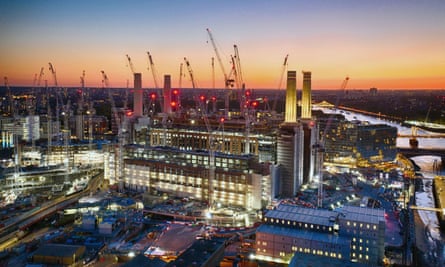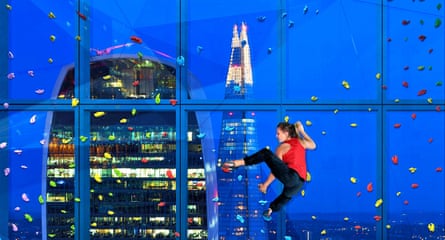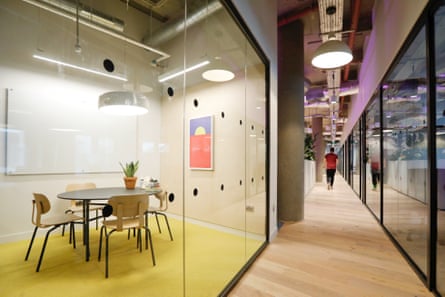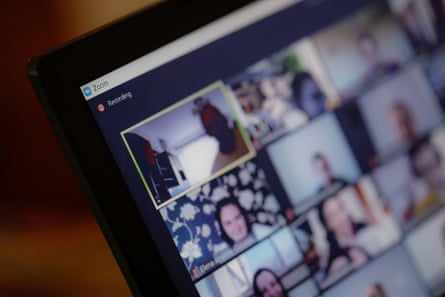The Wodge: can London’s tallest new skyscraper survive the Covid era?
With the City of London deserted once more, its streets only populated by the occasional Deliveroo driver or tumbleweed-seeking photographer, it seems a strange time to be completing the largest office building the capital has ever seen, not least because the very future of the workplace is now in question.
But, rising far above the Cheesegrater and the Walkie-Talkie, dwarfing the now fun-sized Gherkin and boasting the floor area of almost all three combined, 22 Bishopsgate stands as the mother of all office towers. It is the City’s menacing final boss, a glacial hulk that fills its plot to the very edges and rises directly up until it hits the flight path of passing jets. The building muscles into every panorama of London, its broad girth dominating the centre of the skyline and congealing the Square Mile’s distinctive individual silhouettes into one great, grey lump.
It is the absurdist conclusion of three decades of steroidal growth, the final product of superheated land values stretching loose planning rules to breaking point. And, just as the building is being handed over to its first tenants to fit out, it feels like a monument from another epoch. Remember when we used to commute to the office?
 View image in fullscreenGargantuan … Apple is buildng an HQ in the former Battersea Power Station. Photograph: Chris Gorman/Getty Images
View image in fullscreenGargantuan … Apple is buildng an HQ in the former Battersea Power Station. Photograph: Chris Gorman/Getty Images
“Twenty-two Bishopsgate reminds me of a catchphrase from the 1960s sitcom,” says Peter Rees, former chief planner of the City of London: “Never Mind the Quality, Feel the Width!” Rees oversaw the transformation of the City from the mid-1980s until 2014, summoning ever-larger structures into being, but he left his post shortly before this tower was granted permission. “I wasn’t responsible for that one,” he says. “Thankfully, I think it marks the end of an era of buildings of that intensity, the idea that more is better.” Certainly, post-Covid, the big question seems to be: will people want to commute to a mega-building and jostle for the lifts with 12,000 others?
The beast of Bishopsgate, nicknamed The Wodge by one critic, may be the last gasp of this generation of inflated totems, but it is by no means alone. It heralds a flood of new office space at a time when it could hardly look less needed. Across London, some of the biggest corporate HQs ever built in the UK are under construction, from Google’s sprawling, ground-scraping Goliath in King’s Cross, to Apple’s gargantuan new home inside the zombified cadaver of Battersea Power Station. And those are just the giants. According to a recent report by Deloitte, over 15 million square feet of office space is on the way in central London. That’s the equivalent of 30 Gherkins, a peak of activity last reached in 2008, just as the bubble burst.
Twenty million people can get to our building within an hour – and many are yearning to get back to the office
The City bounced back from the financial crisis, but this tidal wave comes as the country is facing the worst economic recession for 300 years – along with speculation that the nature of work might have changed for ever. Google itself has extended home-working until at least July, while investment bank Morgan Stanley has predicted that the number of people working from home will more than double to 30% by 2030.
Deloitte’s research also found that, compared to other European countries, UK employees are the least willing to return to their offices, with 72% saying they will work remotely more often in the future. The market is reflecting this uncertainty: central London office take-up plummeted in the six months to September, with the latest quarter the lowest on record. Just as factories and mills were converted into luxury lofts, and postwar offices converted into grim bedsits, might today’s glass office towers be the high-rise homes of tomorrow?
 View image in fullscreenGet a grip … the climbing window on the 25th floor of 22 Bishopsgate. Photograph: Miller Hare/22 Bishopsgate
View image in fullscreenGet a grip … the climbing window on the 25th floor of 22 Bishopsgate. Photograph: Miller Hare/22 Bishopsgate
“City-centre offices are the product of a 10,000-year trend,” says Harry Badham of AXA IM Real Assets, the firm behind 22 Bishopsgate, which is already around 60% pre-let. “We are a long-term investor, so we take the long view. People work better together. That’s how cities were created and we don’t think that’s going to change overnight. Twenty million people can get to our building within an hour, and many are yearning to get back to the office.”
With 1.3m sq ft of space and a whopping 60 lifts, the tower’s first occupants will at least have enough room to be socially distanced, whether they’re relaxing in the nail bar on the 41st floor or scaling the precipitous “climbing window” on the 25th. But the prospect of being trapped inside this “vertical village” – with restaurants, bars, gym and even a GP’s surgery – might not be quite the draw it once was. Do you want your work life to be permanently “coached and curated”? Are all these communal facilities – such as Google HQ’s swimming pool, massage rooms, basketball court and nap pods – really the future?
Rees believes that – having survived the Black Death, the Great Fire and the Blitz – the Square Mile will bounce back
“Giant buildings that try to internalise the place are making a big mistake,” says Rees, now professor of planning at University College London. “The most important places in the City are outdoors and the pandemic has certainly taught us that. People need to get out of the office to get the gossip and bring it back to the beehive. That proximity, and those face-to-face encounters, have been the foundation of doing business here since medieval times.” Rees thinks that, having survived the Black Death, the Great Fire, the Blitz and the banking crashes, the Square Mile will soon bounce back even stronger from the impact of Covid-19. “The City has always been adapting and reforming,” he says. “Its only constant is change.”
Ziona Strelitz, a social anthropologist and veteran workplace consultant, thinks the pandemic will provide a wake-up call for businesses, forcing them to reconsider how they use their costly premises. And this may bring a welcome end to wasteful interior fads. “The last decade,” she says, “has seen an explosion in so-called ‘new ways of working’, with offices equipped with informal meeting spaces, chill-out rooms, libraries and coffee bars. These settings were a huge liberation for interior designers: they could stop doing serried rows of desks and introduce some photogenic funk. But there wasn’t the correlate reduction in the number of desks elsewhere. As a result, offices are vastly underoccupied most of the time – about 50% occupancy or less, pre-pandemic. Now it’s even lower.”
 View image in fullscreenGroundscraper … a drawing of Google’s new UK HQ, under construction in King’s Cross. Photograph: HayesDavidson
View image in fullscreenGroundscraper … a drawing of Google’s new UK HQ, under construction in King’s Cross. Photograph: HayesDavidson
She mentions a large telecoms provider she worked with, whose staff moved from a huge, award-winning, grade-A office building to a series of smaller, converted former technical spaces – and they were happier as a result. “They knew everyone on their floor and were no longer rattling around in the Mary Celeste,” she says. “They could actually walk over and speak to someone.”
Strelitz thinks the biggest impact of Covid-19 will be that companies contract their holdings and use space more efficiently, a view echoed by Deloitte’s prediction of a 15% reduction in demand. “It’s not the death of the office,” she says, “but it’s hopefully the end of offices growing exponentially.” And the fate of the collaborative beer-tap-ping-pong-bean-bag-lounge? “It’s all a bit of a nonsense. These spaces don’t bear a relationship to how people actually choose to work. Collaboration happens in the immediacy of a horizontal surface and two bums.”
She agrees with Rees that a hybrid new space is likely to emerge, somewhere between the home and the office, where you can escape from the kitchen table laptop grind, without enduring the daily commute. We are likely to see a rise in shared neighbourhood offices, perhaps taking over vacant shop units on the high street or former department stores, which would be no bad thing. “People want the buzz of work around them,” says Rees, “the chance to network with individuals doing something very different. That’s why even large corporations started taking space in co-working buildings like WeWork. They realised they could eavesdrop on a lot of other people’s creative ideas.”
 View image in fullscreenNetworking … a WeWork meeting room at No 1 Poultry, in the City. Photograph: Bloomberg/Getty Images
View image in fullscreenNetworking … a WeWork meeting room at No 1 Poultry, in the City. Photograph: Bloomberg/Getty Images
Across London, many of the big landlords have been following WeWork’s lead, leasing space to smaller outfits on a more flexible basis, rather than looking for major anchor tenants. Despite hawking the biggest office in the capital, Harry Badham admits that the future of the workplace is smaller tenants leasing smaller spaces. “We’ve always said we want to be the only landlord in London to lease you less space,” he says. “We’re providing the communal facilities for the whole building so you don’t have to.”
The pandemic has severely tested the co-working business model, though, given how tightly desks are usually packed in, but the fall in demand has also been offset by businesses looking for temporary accommodation as a result of the uncertainty. Despite its financial troubles, WeWork remains the biggest office occupier in both London and New York.
For all the talk about a remote-working future, the death of the office, the freedom of moving to the country, or even working from a roaming van, there remains a huge generational divide in the experience of working from home. A recent study by ISG found that millennials and generation Z (people born since the early 1980s) were least happy and suffering the most, with a third saying productivity had fallen and almost two-thirds complaining of poor home-working conditions.
 View image in fullscreenZoom culture … younger employees in particular report poor working conditions and productivity at home. Photograph: MoiraM/Alamy Stock Photo
View image in fullscreenZoom culture … younger employees in particular report poor working conditions and productivity at home. Photograph: MoiraM/Alamy Stock Photo
Meanwhile, in the City, confidence is already bubbling back. In November, the City of London Corporation received more planning applications than the same month last year, meaning incoming proposals are now exceeding pre-pandemic levels. “Ever since I started directing City planning in the 1980s,” says Rees, “journalists were telling me that most people will be working from home within 10 years, thanks to the telephone, fax and then the internet. But the more that technology invaded people’s jobs, the more they wanted to come face to face to bounce ideas off each other, or learn if they could trust one other.” As the pandemic has shown, you can’t really gossip on a group Zoom.
It looks like those predicting the implosion of the office might have to cancel their dreams of squatting the City, co-opting Canary Wharf, and turning all these gleaming glass towers into high-rise greenhouses. Once the vaccine is dispensed, they will be back in action, and very much here to stay.
This article was amended on 13 January 2021 to remove a mention of the comedy series The Rag Trade. Never Mind the Quality, Feel the Width was the name of a separate series.



